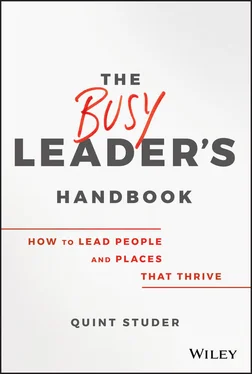The authors write that their study “tells us a lot about the dynamics of leadership selection and helps to explain why the people who are chosen as leaders by independent selection panels often fail to deliver when they are in the thick of the group that they actually need to lead.”
Here’s the bottom line: in order to be perceived as leadership material, people often do things to showcase how they are “special” or “different.” But the irony is that the best leaders are the ones who fit nicely with the group and think of themselves as followers.
I see two big lessons here for business owners and leaders:
First, when selecting leaders, choose true team players who have the capacity to form strong and meaningful relationships with employees. Choose those that give credit away.
As Peters and Haslam explain in the HBR article, elevating those who try to distance themselves from the group “encourages leaders to fall in love with their own image and to place themselves above and apart from followers. And that is the best way to get followers to fall out of love with the leader. Not only will this then undermine the leader’s capacity to lead but, more importantly, it will also stifle followers’ willingness to follow.”
Second, if you are a leader, don’t try to “seem” like a leader. Focus on teamwork and strive to create close relationships with your employees. Instead of trying to differentiate yourself, try to fit in.
We need to remember that we’re all followers. We’re all following the purpose our company exists for in the first place. Being able to do that, and do it well with people we care about, is its own reward.
No man, or woman, is an island. We all exist in relationships with other people, whether they’re leaders, employers, board members, colleagues outside the company, family members, or friends. Sometimes we lead, sometimes we follow, but no matter what, we should strive to be the best human being we can be. Remember that and most of the time you’ll do the right thing for all concerned.
1 1 Kim Peters and Alex Haslam, “Research: To Be a Good Leader, Start by Being a Good Follower,” Harvard Business Review, August 6, 2018, https://hbr.org/2018/08/research-to-be-a-good-leader-start-by-being-a-good-follower.
4 Quiet the Ego and Lead with Humility
Great leadership is not always about being “right.” In fact, it rarely is. The leader’s job is to bring out the best in employees and to engage them in working together to do what’s best for the company. This cannot happen when a leader is too attached to their own ideas or convinced that they are the smartest person in the room. That’s why humility is one of the most important traits a leader can have.
Let’s start by getting past the notion that humility is about being meek or submissive or thinking you aren’t good enough. It’s none of these things. We can take pride in our work and have confidence in abilities and also be humble. Humility is about seeing oneself as one truly is. We know our strengths and our weaknesses. When we’re good at something and we receive a compliment, we don’t deny it. When we make light of our skills it can make others feel bad. Rather, we’re grateful that we’re in a position to help others develop that strength.
Leading with humility is about taking oneself out of the center of the equation, about keeping the spotlight on others. It’s about quieting the ego so we’re open to learning and we’re focused on continuous improvement and growth.
Humble leaders don’t assume they have all the answers. They know that an inflated ego can cause them to make bad decisions and lead the team down the wrong path. Also, it can alienate employees rather than engaging them, create dependency rather than ownership, and promote individualism rather than teamwork. It can also send the wrong message about learning—which is especially dangerous in a time when learning is the key to survival.
In a global economy where everything changes rapidly— marketplaces, competitors, consumer behavior, technology, etc.—organizations must be able to quickly shift in response. They must be great at innovating, problem solving, and practicing all the other soft skills that are so important and valued. An openness to learning (in fact, a love of learning) is at the heart of all of this—and humility is at the heart of that.
In this arena, as in others, leaders must set the example for everyone else. When they’re constantly questioning and seeking new perspectives, new knowledge, and better ways to do things, others will follow their lead. Collaboration, teamwork, and innovation flow from there. This commitment to continuous learning is how your company gets better and better.
So what does humility look like in action? For starters, humble leaders are those who direct their focus outward. This gives them a situational awareness that serves the company well. When we intentionally focus on other people, we notice things we might not have seen otherwise. We pick up on body language and subtext. This allows us to see things others miss and helps us build stronger relationships.
Leading with humility means we don’t mind seeking the input of others before making decisions. This allows us to harness the intelligence of the entire team. In an incredibly complex world there is no way one person can know it all.
It means we never push our self-interest over that of the group. We make hard decisions with everyone’s needs in mind, not just our own. We know that a rising tide lifts all boats.
Also, leading with humility means we don’t mind asking for help. And because humble leaders are well-liked and appreciated, we will receive it. People are much more likely to help those who don’t come across as know-it-alls or showoffs.
First, Diagnose: Do You Have a Humility Problem?
The first step to getting better is always being aware that one has a problem. Hold up the mirror and ask yourself a few questions:
Are you constantly reminding the people around you of how great or talented you are? Your ability should be evident in the work that you do. People will notice, and your credibility will come about organically.
Are you concerned with what you “deserve”? Do you feel you should get special treatment because of your position or abilities?
Do you find yourself name dropping, or talking about who you know to feel important?
Do you require a lot of positive reinforcement? For instance, do you point out your own shortcomings as a way to fish for reassurance, or do you reject compliments when people offer them? When you know your own value, you don’t need to do this.
Are you a perfectionist? Do you overreact to others’ mistakes? These can signal a lack of humility because they imply that you believe you try harder than (and are better than) everyone else.
Are you self-righteous? Do you find yourself judging others (often openly) and talking about how you would never do the things they do?
Do you take credit for things that were actually a team effort?
Do you feel that menial tasks are beneath you?
Are you inflexible, exhibiting a “my way or the highway” mentality?
What are your motives? Do you go above and beyond because you value success of the organization, or do you do it to gain affirmation?
These questions can help you become aware of any red flags that may signal a lack of humility. Hopefully, very few of them apply to you, but most of us have humility slip-ups from time to time. The key is to be aware of it and rein in the ego when it starts getting out of control.
When we get intentional and proactive about leading with humility we will naturally shift to a healthier state of mind. The ego will assert itself less and less. Here are a few tips:
Читать дальше












